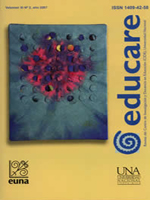La incorporación de ejes transversales en la educación superior: el marco institucional y el acompañamiento como condiciones para el éxito
DOI:
https://doi.org/10.15359/ree.11-2.2Keywords:
transverse axes, educationAbstract
The National University decided to include five institutional transverse axes in the curricula. In order to be successful, a process was undertaken, that considered two fundamental components: the institutional framework and joint work with professors and departments, as a mean of reducing barriers that could interfere in the inclusion of gender, sustainable development, environment and environmental culture, equity and cultural diversity in curricula.
In this paper are included, the institutional framework and the aspects that were considered during the joint work as well as the training provided to faculty and chairpersons during the process.
References
Ajzen, I. y Driver, B. L. (1991). "Prediction of leissure participation from behavioral, normative and control beliefs: An application of the Theory of Planned Behavior". Leissure Sciences (13), 185-204.
Benayas, J. y Alba, D. (s.f.) El reto de la ambientalización universitaria. Recuperado el 13 de enero del 2006, de http//www.usc.es/-calidad/doc/e-boletin%20maio.
Charpentier, C. y Jiménez, L. (2006). "La inserción de ejes transversales en la Universidad
Nacional es un proceso flexible y participativo". Revista Contexto
Normalista 2: saldrá en los próximos meses.
Charpentier, C., Hernández, L., Zúñiga, C., Brenes, O. E., Mata, A., Carrillo, M. A., y Zúñiga, M. E. (2002). Comisión lnteruniversitaria de Educación Ambiental.
"Indicadores que hay para medir la incorporación de la dimensión ambiental en los currícula de las universidades estatales de Costa Rica". Revista de Ciencias Ambientales (22), 40-43.
Charpentier, C. y Ham, S. (1997). "Una nueva perspectiva para clasificar barreras
para la incorporación de la dimensión ambiental en la educación superior en Costa Rica". En: Arnáez, E. y Rojas, S. Experiencias para la incorporación de la dimensión ambiental en el quehacer universitario. Consejo Nacional de
Rectores, Costa Rica (OPES-07/97).
Charpentier, C. (1995). Barriers to environmental education in Costa Rican State Universities: Theory, analysis and recommendations for interven/ion programs.
Published doctoral dissertation, University ofldaho, Moscow.
Consejo Universitario. (2003a). "Políticas y Lineamientos Curriculares". SCU-279- 2003. Gaceta 3.
Consejo Universitario. (2003b). "Políticas y Lineamientos Curriculares". SCU-820-. 2003. Gaceta 3.
Díaz-Barriga, F. y Hernández, G. (1998). Estrategias docentes para un aprendizaje significativo, una interpretación constructivista. México: MCGRAW-HILL.
Dirección de Docencia. (2003). Programa de Evaluación y Gestión de la Calidad Académica, Comisión de Vicedecanos y Vicedecanas, Dirección de Docencia, Universidad Nacional. Incorporación de ejes transversales en los planes de estudio. (http:// www.una.ac.cr/pev¡0.
Emmons, K. (1997). "Perspectives on environmental acting: reflection and revision
through practica! experience". Journal of Environmentq.l Education 29 (1 ),
-44.
Ham, S. y Sewing, D. R. (1988). "Barriers to Environmental Education". Journal of Environmental Education 19 (2), 17-24.
Mata, A., Zúñiga, C., Brenes, O., Carrillo, M. A., Charpentier, C., Hemández, L. y Zúñiga, M. E. (2003). Informe final Dimensión ambiental: estrategias innovadoras para la formación docente. Coordinación Educativa Cultural Centroamericana
(CECC). Costa Rica: IMPRESORA OBANDO.
Mata, A., Zúñiga, C., Brenes, O., Carrillo, M. A., Charpentier, C., Hemández, L. y Zúñiga, M. E. (2002). "Dimensión ambiental: estrategias innovadoras para la formación docente". Coordinación Educativa Cultural Centroamericana (CECC), Colección Pedagógica Formación Inicial de Docentes Centroamericanos en Educación Primaria o Básica. Volumen 27.
Política Ambiental Universidad Nacional, Acta Nº 2472, Gaceta Nº 7, 30 junio del 2003.
Romero, R. (1991). "La dimensión ambiental en la formación de profesionales universitarios". Revista de Ciencias Ambientales 7. pp. 112-115.
Universidad Nacional (2004). Plan Global Institucional 2004-2011. UNIVERSIDAD NACIONAL.
Published
How to Cite
Issue
Section
License
1. In case the submitted paper is accepted for publication, the author(s) FREELY, COSTLESS, EXCLUSIVELY AND FOR AN INDEFINITE TERM transfer copyrights and patrimonial rights to Universidad Nacional (UNA, Costa Rica). For more details check the Originality Statement and Copyright Transfer Agreement
2. REUTILIZATION RIGHTS: UNA authorizes authors to use, for any purpose (among them selfarchiving or autoarchiving) and to publish in the Internet in any electronic site, the paper´'s final version, both approved and published (post print), as long as it is done with a non commercial purpose, does not generate derivates without previous consentment and recognizes both publisher's name and authorship.
3. The submission and possible publication of the paper in the Educare Electronic Journal is ruled by the Journal’s editorial policies, the institutional rules of Universidad Nacional and the laws of the Republic of Costa Rica. Additionally, any possible difference of opinion or future dispute shall be settled in accordance with the mechanisms of Alternative Dispute Resolution and the Costa Rican Jurisdiction.
4. In all cases, it is understood that the opinions issued are those of the authors and do not necessarily reflect the position and opinion of Educare, CIDE or Universidad Nacional, Costa Rica. It is also understood that, in the exercise of academic freedom, the authors have carried out a rogorous scientific-academic process of research, reflection and argumentation thar lays within the thematic scope of interest of the Journal.
5. The papers published by Educare Electronic Journal use a Creative Commons License:














 The articles published by Educare Electronic Journal can be shared with a Creative Commons License:
The articles published by Educare Electronic Journal can be shared with a Creative Commons License: 



